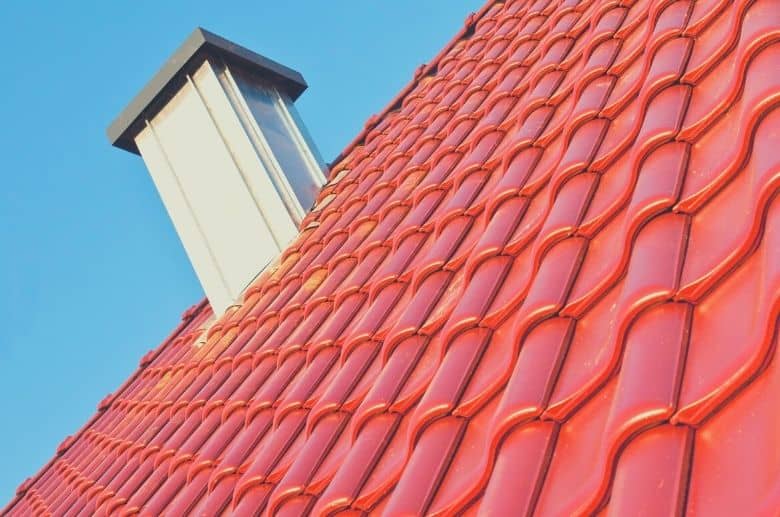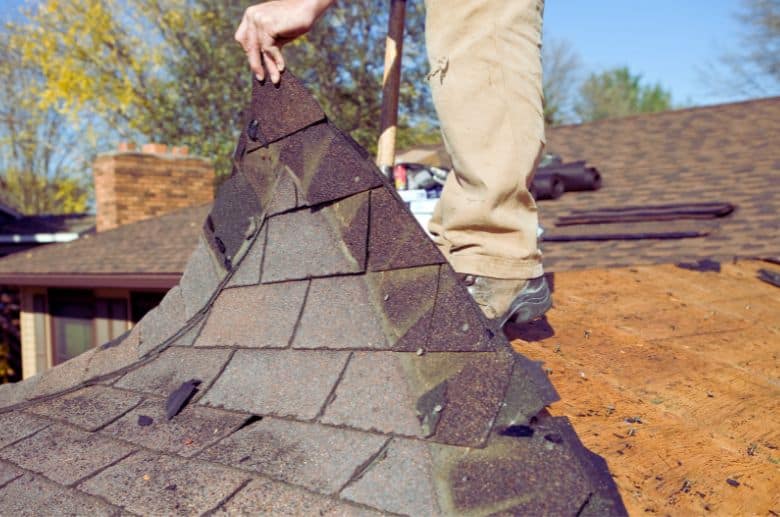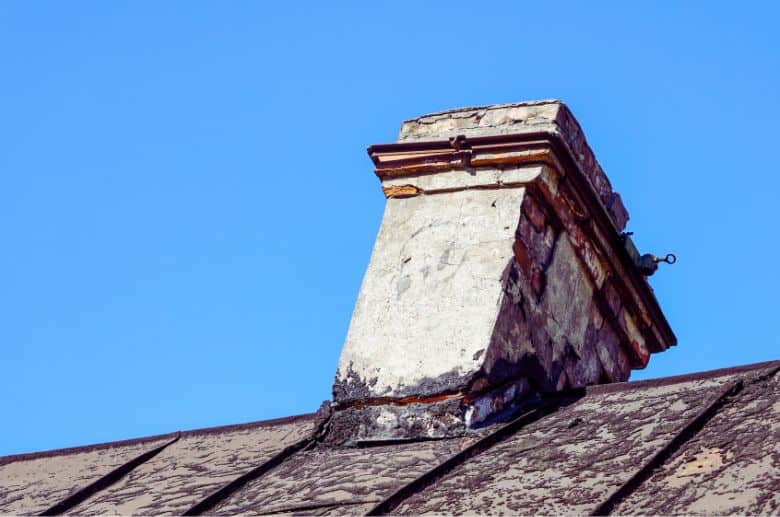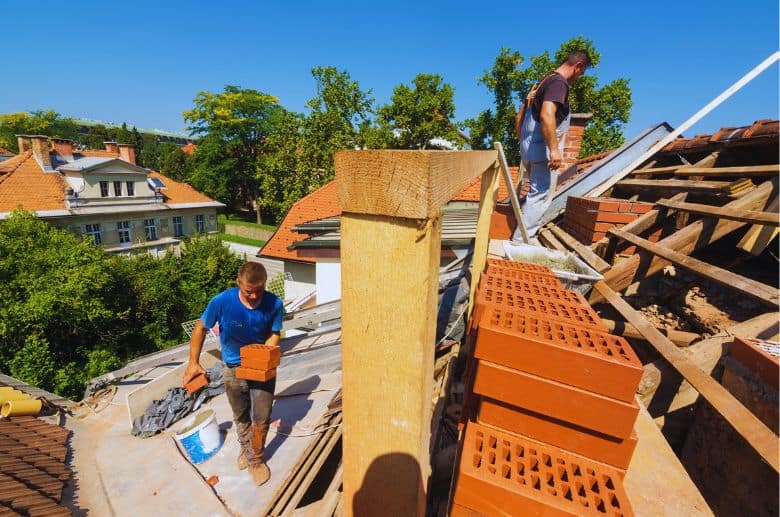Leaning chimneys can pose health and safety risks. It is in the best interest of homeowners to get them rebuilt as soon as possible. But how do I know when I need to rebuild leaning chimney?
You can look for multiple signs, such as water problems, chimney stack damage, crown damage, etc. We’ll talk about them further down the article, but first, let’s find out what causes a chimney to lean in the first place:
What Causes a Chimney to Lean?

A leaning chimney can be caused by several factors, including:
- Poor construction
- Masonry decay
- Missing/damaged footing
- Water issues (e.g.mold, growth, mortar decay, rust, etc.)
- Expanding soil
A typical chimney weighs several tons, all concentrated in a small area. Such a massive structure can start to lean eventually without a proper cement footing (or chimney pad.) Unfortunately, several old chimneys were constructed without a footing, causing them to lean.
But, as per various building codes, chimney footings are now mandatory. According to the International Residential Code and the 2020 New York state building code, your chimney footing should be 12″ thick and 6″ wide on each side of the fireplace wall.
If your chimney footing is made from sub-par materials, is too narrow, or is not deep enough into the ground, it won’t be able to bear the weight of your chimney, causing it to lean eventually.
Chimney masonry is exposed to environmental elements that can have detrimental effects, especially when lacking maintenance. Over the years, the masonry starts to decay, with cracks forming in the bricks and mortar joints. This weakens the chimney’s brick-and-mortar structure, causing it to lean.
Chimneys can also start to tilt because of shifting soil. A lack of proper drainage or too much sand are common causes of soil shifting.
Most of these issues can be avoided with regular maintenance and vigilance. If homeowners know the signs of chimney damage, swift action can be taken to fix the underlying issues and avoid further damage.
——
Do You Need to Hire Chimney & Fireplace Expert?
Get free quotes from qualified experts near you. No commitment required!
——
How Do I Know When I Need To Rebuild Leaning Chimney?
Signs of water damage such as rust and efflorescence, crumbling mortar, and cracks are obvious signs that your chimney needs to be rebuilt. Unfortunately, you can’t be aware of all the signs, e.g., you cannot know about a cracked chimney liner through a DIY inspection. That is why it is important to call in chimney experts for a thorough inspection if you face chimney problems.
Here are some signs to look out for:
1. Tilting Chimney
If there’s an obvious tilt or lean in your chimney, that means something’s seriously damaged in your chimney. In such cases, it’s best to avoid using your chimney and hire a professional service for a thorough inspection.
If you just bought a home or you’re looking to buy one, notice if there’s caulking in the gap between the tilting chimney. If there is caulking, that means the previous homeowner tried to fix the lean, and you’ll need a proper chimney inspection before using it. If you buy a house with a leaning chimney, either negotiate the price to factor in the cost of inspection and repairs or ask the seller to bear the costs. But is the seller legally obligated to fix the chimney? Well, it usually depends upon mutual agreement.
2. Water Damage

A leaning chimney is likely to leak because of cracks and gaps created by the tilt. If your chimney leaks, the water seeping inside can damage your chimney. Ignoring leakage can lead to significant damage, making a chimney rebuild necessary. Water can cause moisture and rust inside your firebox. You’ll notice rust on your damper, causing problems in opening and closing.
Water can also get inside the gap between your chimney and chimney liner (flue.) This results in shaling flue tiles. The water erodes the flue tiles, and thin pieces start to fall off. Cracks begin to form, increasing the chances of a chimney fire.
3. Chimney Crown Damage
Your chimney crown is the first defence against rain, snow, and the harsh weather outside. Since it’s on the frontline, it bears the most damage. Eventually, it starts to damage, and cracks begin to form on its surface. If these cracks aren’t dealt with, over time, the cracks expand, allowing more water to seep inside. The water then seeps inside the chimney spreading the damage.
In worst cases, a damaged crown can necessitate a chimney rebuild.
4. Spalling Brick and mortar Damage

While your chimney exterior is built from durable materials, the mortar (that holds the whole structure together) can start to crumble. Using low-grade construction materials, water damage, and weathering are some of the things that cause chimney mortar to crumble.
Crumbling mortar cannot hold the bricks together, so they start to loosen.
Similar to crumbling mortar, water is also responsible for spalling. When the chimney bricks get saturated with water, they start to deteriorate. Cracks start to form, allowing more water to seep inside. Eventually, the bricks start to crumble and fall off. Thus, the complete chimney structure is at risk of falling off.
——
Do You Need to Hire Chimney & Fireplace Expert?
Get free quotes from qualified experts near you. No commitment required!
——
What are the Different Types of Chimney Rebuilds?
Most homeowners get scared off by a chimney rebuild, thinking it entails thousands of dollars of expense. While it is true in some cases, it’s not always the case. It’s important to understand the different categories of chimney rebuilding to get an idea of the kind of work and expense that’ll go into each one.
Chimney rebuilding can be categorized into the following:
Partial
If only a few external layers of a portion of your chimney are crumbling or spalling, you’ll need a partial rebuild. If you have a smaller chimney, reconstructing it completely is included in a partial rebuild.
Since only a portion of your chimney is required, scaffolding isn’t needed in a partial rebuild. It’s also less expensive in comparison to other types of chimney rebuilds.
Roofline Up
If the damage is above the roofline, i.e., the entire chimney stack needs reconstruction, you’ll need a roofline up rebuild. Brick spalling, serious cracks, and crumbling mortar above the roofline hint towards a need for a roofline-up rebuild.
It’s more expensive than a partial rebuild but less expensive than a complete rebuild.
Complete

If the chimney problems have been ignored for a significant period, the damage can spread throughout the chimney. In such cases, the entire chimney needs to be rebuilt.
A complete rebuild usually requires scaffolding and considerable labor work, making it the most expensive of the three.
Which Chimney Rebuild is Best for Your Leaning Chimney?
Only a chimney expert will be able to suggest to you what type of rebuild is best for your leaning chimney. But since a leaning chimney usually points towards some serious underlying chimney problems, a complete rebuild is usually recommended.
But, again, it depends upon the extent of the damage and the kind of repairs required. If only the top stack is affected, you might need a partial or roofline-up rebuild.
Usually, the tilt is caused by foundation problems, so you might also have to install helical piers to support the chimney foundation after getting it fixed.
How Much Does a Complete Chimney Rebuild Cost?
A complete chimney rebuild usually costs around $5500 to $13500 depending upon the size of your chimney. Other factors that contribute to the cost include the cost of labor, materials used, the extent of the damage, and the ease of accessibility.
——
Do You Need to Hire Chimney & Fireplace Expert?
Get free quotes from qualified experts near you. No commitment required!
——
Benefits of Rebuilding Your Leaning Chimney
If we compare the cost of chimney rebuilding with its benefits, we’ll see that the benefits far outweigh the expense. Below is a description of some of the most important benefits of rebuilding your chimney:
Safety
A leaning chimney is dangerous, not only is it at risk of falling at any time, but it also causes multiple issues throughout the chimney that leads to further health and safety risks. For example, a leaning chimney can crack the liner, leading to drafting issues, chimney smoke problems, and increased chances of a chimney fire.
A thorough chimney inspection and rebuilding ensure all these issues are fixed, ensuring a safe and efficient chimney.
Prevention of Chimney Leaks
When a chimney tilts significantly, the chimney stack gets cracked. Moreover, a gap is exposed between the chimney and the sidewall of your house. A leaning chimney also damages the chimney flashing.
All these issues increase the chances of water penetration. Ultimately, they lead to water damage in the form of crumbling mortar, lack of structural integrity, white stains, mold growth, and rust.
So if you rebuild a leaning chimney in due time, you can avoid significant water damage and further degradation of your chimney and its parts.
Improved Efficiency
A leaning chimney signifies a damaged chimney. Not only is it dangerous to use a fireplace with a damaged chimney, but it is also inefficient. You’ll be putting yourself and your family at risk while also burning up fuel with little heat in return.
A chimney rebuild ensures that your chimney, with all its parts, works to its maximum potential, using less fuel and providing more warmth.
Cost Saving
Homeowners consider rebuilding to be quite expensive. In reality, you’ll save a lot with a chimney rebuild since it is much cheaper than a chimney replacement. Moreover, rebuilding a chimney, whether partial or complete, also saves you a lot in terms of repairs—consider the damage that your home and chimney would have to bear otherwise.
Increased Value
Since your chimney is one of the first things people look at, first impressions are usually built on it. Considering this, a damaged chimney would considerably hurt the impression of your house. It would also lower the overall value of your house. So before putting your house on the market, it’s important to rebuild your learning chimney for a better evaluation of your house.
Takeaway
A tilting chimney can result in multiple issues, including water damage, structural damage, pest infestation, drafting problems, etc. All these issues point towards a need to rebuild your leaning chimney.
If you don’t get your leaning chimney fixed, the problem can get out of hand, leading to more serious issues such as a chimney fire—in some cases, the chimney might even collapse.
By rebuilding a leaning chimney, you fix all these issues, increase the lifespan of your chimney, and ensure a safe and efficient chimney.
Frequently Asked Questions
How do you prevent rebuilding your chimney?
To prevent rebuilding your chimney, ensure annual chimney inspections as the NFPA recommends. You also need to properly maintain your chimney by fixing faults or replacing damaged parts as soon as possible. Another important thing is to regularly clean your chimney to avoid soot and creosote buildup.
Lastly, get your chimney waterproofed by a professional-grade material that prevents water from penetrating while also allowing the evaporation of water that’s already inside.
How often do chimneys need to be rebuilt?
Chimneys are durable structures that can last 50 to 100 years, after which chimney rebuilding is required. But weathering or aging can cause damage, so regular maintenance and inspection become important. If a chimney is not inspected, cleaned, or maintained, its lifespan can decrease drastically. In such cases, chimney rebuilding is required much sooner than expected.
Can a brick chimney collapse?
A chimney can collapse if there’s significant damage and it is not addressed in due time. The brick-and-mortar chimney has to bear harsh weathers, rain, and snow, which can eventually take a toll.
If a chimney is improperly maintained, the mortar can crumble, and the bricks begin to crack. This allows more water to seep inside the chimney and cause considerable damage in the form of broken chimney liner tiles, rust, and structural damage.
If not fixed in time, the structural damage can get worse, putting the chimney at risk of collapsing.






